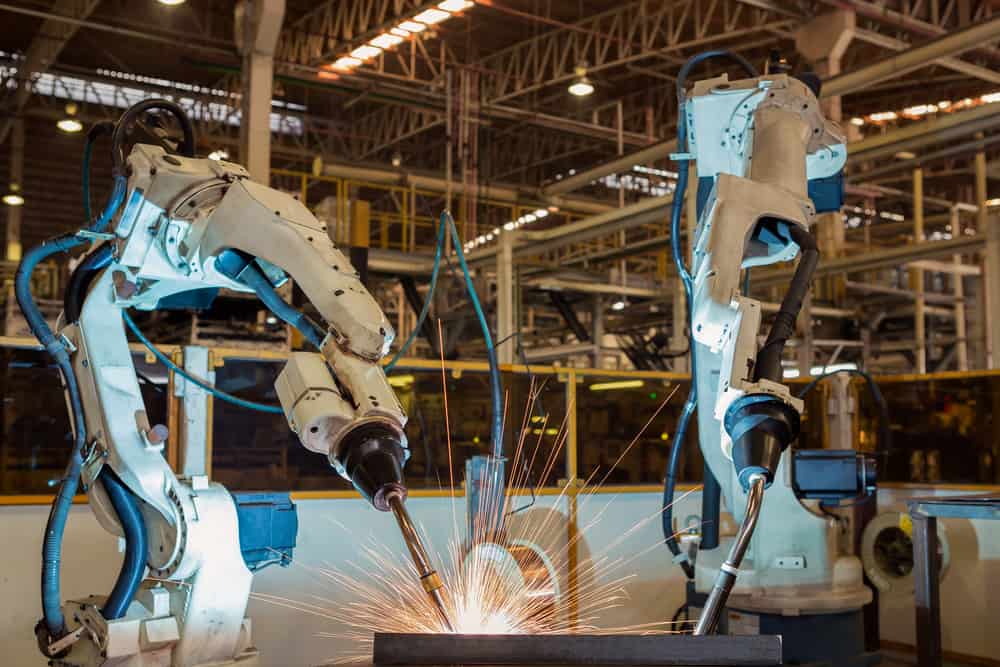
Unimation 001, the first welding robot, was created in 1962. In the early days, heavy automated machinery with less flexibility limited robotic welding to large-scale heavy industries like automotive manufacturing. With today’s refined robotic and computing tools, however, robotic welding has become widely available across manufacturing environments.
This transition has been facilitated by improvements in the integrated IoT (Internet of Things), which has enabled rapid and efficient programming and parameter optimization in an online or offline setting. These advanced functions have allowed industries to increase welding precision while significantly improving productivity.
Implications of Robotic Welding in Manufacturing
Advanced automation and programming capabilities have ensured flexibility and productivity in modern welding operations. Robots can perform tedious tasks that would otherwise require strenuous manual effort. And with the right tools and software, welding parameters can be monitored and optimized without any downtime. Advances in robotic welding have resulted in many positive implications for manufacturing.
Increased Efficiency and Productivity
Robots can work continuously and perform consistent, reliable welds when compared to manual welding. With increased flexibility, the robotic arms can reach tight corners and complex geometries while maintaining high-quality welds. Automation and advanced robotics technology also allow manufacturers to perform faster and less wasteful welds that result in more cost-efficient and productive welding processes across industries.
Improved Quality
By eliminating human error from the welding process, manufacturers can more easily ensure weld precision. Additionally, new programming abilities allow operators to optimize robots and weld parameters to efficiently and effectively perform a fixed set of tasks. Moreover, operators can monitor the weld remotely to ensure they consistently achieve their desired quality standard.
Enhanced Safety
When humans are directly involved in the welding process, industries must prepare for health and safety while maintaining ergonomic provisions. Depending on the material welded, operators risk exposure to hazardous fumes. And in some cases, the geometry of the workpiece or the welding space can make performing the weld either extremely difficult or altogether impossible. Robotic technologies allow manufacturers to eliminate welding injuries and equipment damage while enhancing the overall safety of the welding process.
Improving Productivity With Weld Robot Programming
Consistency and precision summarize the primary goals of programming technology in modern welding equipment. Operators can program the robots to perform a specific set of tasks with consistent weld parameters that alleviate variance in weld results. In the past, programming robotic welding operations would require manufacturers to shut down the production line while performing the programming process. With modern programming software like OCTOPUZ, however, operators can simulate the movement of the welding robot and program it offline while the robot continues its work. This allows industries to reduce the downtime and costs involved in process optimization while significantly improving productivity.
Role of Robotic Welding in Manufacturing 4.0
For critical manufacturing applications, welders must possess high-level skillsets. However, industries that depend on manual welders will still encounter risks due to human error. Likewise, manufacturers will need to prepare for potential safety hazards inherent in manual welding processes. Welding inconsistencies, as well as slower speeds in weld operations, are not suitable for industries aiming to meet the standards of Manufacturing 4.0. Instead of mitigating limitations associated with manual welding, large and small-scale manufacturers are benefitting from advanced robots that automate welding tasks while allowing operators to focus on weld programming and monitoring. With improved precision and consistency, robotic welding in manufacturing allows operators to perform high-quality welds faster so that industries can maintain welding standards while meeting an ever-increasing demand.
Arc Machines, Inc., a leader in welding technology, brings decades of advanced welding expertise to fulfill the manufacturing needs of our clients. Contact AMI to learn more about our robotic welding solutions, or contact sales@arcmachines.com.




